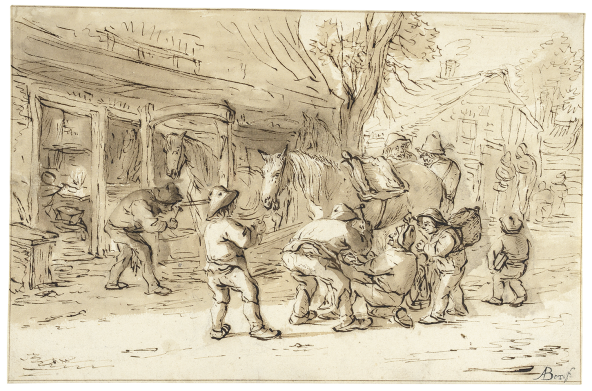Choose a background colour
Andries Both, Dutch, 1611/1612-1641: Crowd Outside an Inn with an Art-Seller, c. 1630-40
Pen and brown ink with gray and brown washes over traces of black chalk on paper; framing lines in brown ink.
10 5⁄16 × 14 5⁄8 in. (26.2 × 37.1 cm)
Verso of backing sheet, lower left, in pen, A 736; lower left, in pencil, André Both; upper left, Srodor [?]; upper center, 20 f; and lower right, 30 f.
- Chain Lines:
- Vertical, 25 – 27 mm.
- Watermark:
- None. Backing sheet with fragment of a crown, probably eighteenth century.
- Provenance:
Sale, Sotheby’s, Amsterdam, 21 November 1989, lot 37; Sheldon and Leena Peck, Boston (Lugt 3847); gift to the Ackland Art Museum, inv. no. 2017.1.12.
- Literature/Exhibitions:
None.
- Ackland Catalogue:
- 2017.1.12
Although his life was cut short by his tragic drowning, Andries Both was known for his lively and humorous paintings of low-life genre scenes and street life. Here, a man raised above the crowd holds a rectangular object, probably a painting, under the shade of a tavern’s canopy. The Dutch market for paintings flourished in the seventeenth century and open-air lotteries and auctions became popular, especially among buyers of limited means. Despite their widespread occurrence, such public sales were rarely depicted in the visual arts, making Both’s sheet a noteworthy example.
Andries Both trained in the Utrecht workshop of Abraham Bloemaert in the late 1620s.1
Although he made a number of notable landscape drawings early in his career, Both is primarily known for the works he produced after he left the country in the early 1630s. He traveled first through France and eventually settled in Rome around 1635, where he joined Pieter van Laer and his followers (the Bamboccianti) as a painter of low-life genre scenes and street life.2
His younger brother Jan Both (c. 1615/22 – 1652) later joined him in Rome and became a notable painter as well, specializing in Italianate landscapes. Andries tragically met his demise in Venice in 1642 when he fell into a canal and drowned, cutting short the career of one of the most lively and humorous Dutch artists of his generation.
In his drawings, which deserve more study, Andries could be remarkably varied in his handling, subject matter, and degree of finish. When the Peck drawing first emerged in 1989, it bore an unconvincing attribution to Barend Graat (1628 – 1709). The removal of the old mount by the auction house, however, revealed an older and far more plausible attribution to “André Both” on the verso, probably written by a French collector or dealer in the nineteenth or early twentieth century.3
Both’s confident handling of the well-charged pen to generate the forms of the figures using short, swift strokes are comparable to those found in his signed Village Smithy in Dresden Fig. 14.1.

Andries Both, The Village Smithy, c. 1630 – 35? Pen and brown ink and brown wash on paper, 201 × 305 mm. Dresden, Kupferstich-Kabinett, inv. no. c 1244.
Kupferstich-Kabinett, Staatliche Kunstsammlungen Dresden. Photograph Andreas Diesend
This is especially true for the figures under the canopy on the left side of the Peck drawing. For those on the right, exposed to direct sunlight, he used longer, drier strokes and left a greater reserve of the paper to suggest stronger illumination. At first glance, the gray washes appear to have been added later, but it is also possible that Both applied these himself, especially since they reinforce the building of zones through light and shadow. The broad energetic strokes in brown wash in the background boldly add a sense of dappled light to this outdoor scene.
Although dating Both’s drawings can be difficult, the Peck sheet is arguably one of his earlier works. The slightly later drawings he made in Italy betray a more liquid handling of the pen. Furthermore, both this sheet and the Village Smithy in Dresden seem more like Northern subjects, among those he perhaps made before he departed the country, or produced during an early phase of his travels, which included a stopover in Rouen.4
The glass windows with pointed-arch architecture suggest a more Northern setting for this work, as does the form of the house in the distant background to the right.
As for the subject matter, the raised figure under the canopy appears to be holding aloft a painting. The details are difficult to discern, but it might depict a landscape with a windmill. If this man is indeed showing the gathered crowd a painting, then this would be an especially rare image of an open-air art sale. Despite the famously lively market for paintings the Dutch enjoyed at the time, their actual sale in public remains poorly represented in the iconography of the era, though there are occasional representations of artists being visited by collectors and connoisseurs in their studios.
Open-air lotteries and auctions were especially popular in the Low Countries at the time. 5
Such sales could put artworks within reach of those who could not otherwise afford them, an aspect which may play a role in the humor ostensibly at play here. The drawing likely represents an auction rather than a lottery, the latter tending to be elaborate affairs with many types of objects that lasted many days.6
Auctions of paintings, on the other hand, could also take place in taverns like this. We have direct knowledge of one such auction held in 1631 at the Coninck van Vranckryck (King of France) in Haarlem, a tavern frequented by Frans Hals and his contemporaries, because the proprietor had to submit a list of artworks to the city authorities for approval before holding the sale.7
Andries Both made other images of street vendors, but they tend to be more charlatan-like in character, and part of the humor in those works is decidedly found in showing just how easily people can be duped. While this image seems innocuous at first glance, one nevertheless wonders if the artist was also taking a jab at the prospective buyers here. If so, he created a self-deprecating and perhaps ironic comment on the eventual treatment and fate of products coming from his own profession, for this is not your usual crowd of art lovers. Or is it?
End Notes
For overviews of Both’s life and works, see Waddingham 1964; L. Trezzani in Briganti et al. 1983, 195 – 202; and for the drawings especially, P. Schatborn in Amsterdam 2001, 88 – 93.
For these early landscape drawings, see Haverkamp-Begemann 1976.
Sale catalogue, Sotheby’s, Amsterdam, 21 November 1989, lot 37. The attribution to Graat was likely made on the basis of comparison with a barn stall interior drawing in the British Museum (inv. no. 1857,0110.2; and Hind 1915 – 31, vol. 3, 105, no. 1), for which the attribution to Graat is questionable, as is the comparison to the present work.
Both’s stopover in Rouen is known from the drawing Drinking Peasants, signed and dated ABoth / Rouen 1633 (Weimar, Schloßmuseum, inv. no. kk 4803); see C. Dumas in Amsterdam 1999, 48 – 49.
De Marchi 1995; and Raux 2018.
For the spectacle of lotteries in the Low Countries, and related imagery, see Raux 2018, 63 – 72, 284 – 87.
See Miedema 1980, vol. 1, 136 – 37, no. A45; and Fucci 2018a, 268 – 69, doc. 74.
